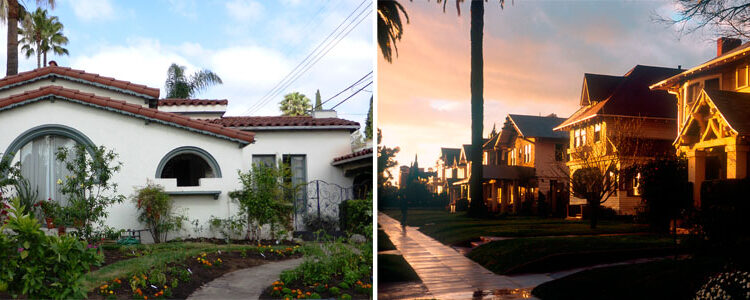
Historic Preservation Overlay Zone (HPOZ)
What is an HPOZ?
An Historic Preservation Overlay Zone, or HPOZ, is a zoning tool that protects and preserves neighborhoods composed of architecturally and historically significant structures. A type of historic district, HPOZs primarily protect single-family residential neighborhoods.
What would an HPOZ mean for me?
An HPOZ may be right for your neighborhood if:
- You would like to prevent demolition and/or inappropriate alterations of historic properties.
- You are interested in developing tailored preservation guidelines to manage change in your neighborhood.
- Your neighborhood would benefit from a community design review process, such as an HPOZ Board.
- You would like to be eligible for property tax relief under the Mills Act program.
Background
In the 1970s, Los Angeles residents grew increasingly alarmed at the erosion of the city's historic neighborhoods. Recognizing the importance of preserving the architectural and cultural legacy of its neighborhoods, the City adopted the HPOZ Ordinance in 1979, paving the way for the designation of historic districts. The newly-formed Conservancy worked with local officials to craft the ordinance.
In September 1983, Angelino Heights became the city's first HPOZ.
As of 2023, City Council has designated thirty-five neighborhoods as HPOZs, ranging geographically from San Pedro to San Fernando and varying in size from two blocks to areas encompassing hundreds of structures. Additional proposed HPOZs are in the pipeline.
For a full list of HPOZs (approved and proposed), visit the Office of Historic Resources' website >>
The first step to designating an HPOZ is to prepare an historic context statement and survey, which outlines the historic, architectural, and cultural significance of a neighborhood and identifies contrbuting and non-contributing structures. Generally speaking, contributing structures date to the period of significance of the neighborhood and do not feature major alterations and additions that compromise the historic integrity. Conversely, non-contributing structures may have been heavily altered and/or constructed outside the period of significance.
Following the survey, residents work with the Office of Historic Resources to develop a preservation plan. The plan, which is unique to each HPOZ, establishes design guidelines and treatment standards for contributing and non-contributing structures. The Cultural Heritage Commission, City Planning Commission, and Planning and Land Use Management Committee review the survey and plan before the full City Council formally adopts the HPOZ.
Once a neighborhood is designated as an official HPOZ, a five-member board is appointed to administer the neighborhood's preservation plan in concert with the Department of City Planning.
In general, HPOZ boards are empowered to review alterations to the facades of contributing structures, including windows, doors, porches, roofs, additions, and seconodary structures. For new construction and non-contributing structures, the HPOZ board enforces guidelines related to massing, orientation, and setback.
HPOZs are among the City's strongest preservation tools and provide a high level of review and protection for historic neighborhoods.
They are not necessarily appropriate for every neighborhood, however, as they are primarily enacted in single-family neighborhoods. In the future, new tools, such as conservation districts, could be appropriate for areas that are not eligible for HPOZ designation.